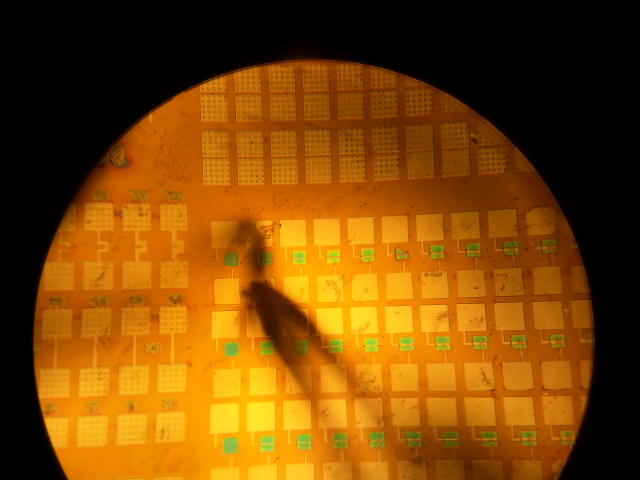| 
Yubo Cui.
Texas State University at San Marcos, Department of Physics,
RFM 2225, 601 University Drive, San Marcos, TX78666.
Yubo Cui |
The growth and properties of RF-sputtered NixFe1-xO deposited at low pressure were studied for possible application in RRAM devices. The following conclusions are made:
1. The normal cleaning procedure for the substrates that is 5 minutes in a sonicator using water, acetone, and isopropyl alcohol is not perfect. A thin layer with a refraction index larger than
fused silica was observed with ellipsometry. The cleaning procedure can be improved by implementing an ozone or plasma clean. Such step reduces the imaginary part of the pseudo dielectric constant by a factor two.
Heating the sample before deposition in the vacuum chamber can further improve the substrate preparation process. A study needs to be performed to see if those substrate preparation steps are compatible
with the liftoff lithography process. Clean interfaces are very important when studying RRAM devices, in particularly RRAM devices that show bipolar switching.
2. The roughing of the back of the substrates with the sandblaster for 30 seconds allows for ellipsometric measurements without polarized back-reflection over a wide spectral range (0.03-6 eV).
PyO films on a roughened substrate show a lower MSE than PyO films measured with a scotch tape on the back. The samples, however, can no longer be used for transmission measurements. We need a method
to partly roughen the back of the substrates.
3. The optical properties of PyO in the infrared can be described by a Lorentzian peak between 377-384 cm-1. We assign this peak to the phonon of rocksalt PyO. This result confirms that RF-sputtered
PyO has the rocksalt structure similar to NiO in agreement with Xray powder diffraction measurements of others. This is an important result as the rocksalt crystal structure in NiO and CoO has been shown to
allow for reproducible resistive switching.
4. The EDAX simulation and measurements estimate the atomic concentration of oxygen in the RF-sputtered PyO is between 30-40% and can be varied by changing the flow rate during the deposition. Assuming
rocksalt crystal structure only 50-60% of the oxygen sides is occupied. Similar results were obtained for Ni0.9Fe0.1O1-x films. The oxygen vacancy concentration estimated of the EDAX data is believed to be to
o high as X-ray 2-theta-scans show diffraction peaks. Future analysis should include measurements on stoichiometric NiO and FeO calibration samples. A better understanding of the Bremsstrahlung spectrum of our samples
is necessary. Among the deposition parameters studied in this thesis, it is believed that the oxygen flow rate is most important for RRAM devices.
5. All our samples show peaks in the epsilon2 spectra below 4.5 eV. The peak is very large for PyO films sputtered at 600oCelsius on glass substrates but lower for similar PyO films sputtered on Si/SiO2 wafers, suggesting
the glass changes at such high temperatures. The low energy peak is also larger for samples made at low Oxygen flow rate. It is believed that the reduction of the oxide at the higher temperatures and/or incomplete oxidation
are responsible for the low energy peak. This is consistent with the work of others [A. Gosh et al.]. This result suggests that we might be able to determine the resistance state from the optical properties. This could be useful when
studying switching behavior in devices. The behavior of the low energy peak was recently confirmed by DFT calculations [John Peterson et al.].
6. Fitting of only the ellipsometric data of PyO films on glass results in peaks that are not in agreement with the transmission spectra. A better understanding of this fit problem is necessary.
7. Measurements done on a thickness series of PyO samples showed that the PyO samples are not homogeneously through the film thickness. The resistivity and the optical properties vary as a function of the film thickness.
In addition, the samples might be anisotropic as shown by the ellipsometer fitting result.
This is consistent with the results of others on NiO. It is believed that this inhomogeneity is not a problem when applying PyO in RRAM devices.
8. RRAM device wafers were made for NiO, Ni0.81Fe0.19O1-x and Ni0.9Fe0.1O1-x using 20% oxygen flow during deposition. The produced devices showed a on-linear IV
elation with hysteresis. Although memory switching was observed, it is not clear whether the resistive switching originated from a charge effect at the electrode-oxide interface or was caused by the the oxidation/reduction of a
conducting filament. Several points were found during the process of making RRAM devices that need to be improved. The first was the low deposition rate of TiN. A 0.1 Å/s deposition rate is not good enough to make a
100 nm layer. The second was that a rim was found at the edge of each layer of the RRAM memory cell. These so-called litho-ears are due to the deposition on the side walls of the photoresist. The thickness of the
photoresist is too large making it difficult to remove the thin film material deposited on the side walls of the resist. The third problem identified was a large series resistance in the 2pp measurement on some of
the test structures. Special probes with two electrodes need to be used in the future for the characterization of these test structures. These problems first need to be solved before the resistivity perpendicular to the
substrates and the switching properties can be studied.

Publications:
[1] Md. Abdul Ahad Talukder, Yubo Cui, Maclyn Compton, Wilhelmus Geerts, Luisa Scolfaro, Stefan Zollner, FTIR Ellipsometry study on RF sputtered Permalloy-oxide Thin Films, published in MRS Advances spring 2016. doi:10.1557/adv.2016.427.
Presentations/Posters:
[1] Yubo Cui, Wilhelmus Geerts, Fidele Twagirayezu, Stefan Zollner, "IR Ellipsometry on RF sputtered Permalloy Oxide thin films", National APS-March Meeting, 2015, San Antonio, Texas.
[2] Fidele Twagirayezu, Wilhelmus Geerts, Yubo Cui, "Optical Properties of Magnetron Sputtered Nickel Thin Films", National APS-March Meeting, 2015, San Antonio, Texas.
[3] Yubo Cui, Wilhelmus J. Geerts, “The Influence of the Deposition Parameters on the Film Thickness of RF sputtered Permalloy Oxide Thin Films, 6h. International Research Conference for Graduate Students, Texas State University, November 5-6, 2014.
[4] Yubo Cui, Fidele Twagirayezu, Wilhelmus Geerts, Optical Properties of Permalloy Oxide Grown by reactive RF magnetron sputtering, presentation at the 2014-Fall meeting of the Texas Section of the American Physical Society, October 17-19, College Station, 2014.
[5] Leonardo I. Escandon Jackson, Yubo Cui, Wilhelmus J. Geerts, Magnetometer measurements on large samples for magneto-plastic research, Undergraduate Research Conference and Honors Thesis Forum, Texas State University April 24, 2015.
[6] James Shook, Yubo Cui, Md Abdul Ahad Talukder, Tang Xi, Greg McClendon, Alex Zakhidov, Luisa Scolfaro, Wilhelmus Geerts, Sheet resistance measurements on a Fe-doped NiO ReRam Test Chip, oral presentation 2015 TSAPS-Fall meeting Baylor University, October 29-31, Texas.
[7] Yubo Cui, Md Abdul Ahad Talukder, Greg McClendon,Yubo Cui, Xi Tang, Wilhelmus Geerts. Iron Doped NiO Based Resistive RAM Test Chip, oral presentation 7th international research conference for graduate students, Texas State University, Nov. 17-18, 2015.
[8] Md Abdul Ahad Talukder, Yubo Cui, Wilhelmus J. Geerts, Study of the Crystal Properties of Iron Doped NiO using an X-ray Diffractormeter, oral presentation 7th international research conference for graduate students, Texas State University Nov. 17-18, 2015.
[9] Yubo Cui, Electrical and Optical Properties of RRAM, Thesis Texas State University, San Marcos, summer 2016 (thesis).
Yubo graduated from Texas State University in August 2016 and is currently enrolled in the Mechanical Engineering PhD program at Southern Methodist University.
|
|



